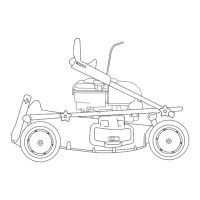14
WARNING
POTENTIAL
HAZARD
• The
blade is sharp.
WHAT CAN HAPPEN
• Contact
with a sharp blade can cause serious
personal injury
.
HOW TO AV
OID THE HAZARD
• Wear
gloves or wrap the sharp edges of the
blade with a rag.
1.
Stop the engine and pull the wire of
f of the spark plug
(Fig. 17).
WARNING
POTENTIAL
HAZARD
• Gasoline
is extr
emely flammable, highly
explosive and under certain conditions can
cause personal injury or pr
operty damage.
WHAT CAN HAPPEN
• Tipping
the mower may cause fuel leakage
fr
om the carbur
etor or fuel tank.
HOW TO AV
OID THE HAZARD
• Avoid
fuel spills by running the engine dry or
r
emoving gas with a hand pump; never siphon.
2.
Drain the gasoline from the fuel tank. Refer to the
Draining Gasoline section, page 12.
3. T
ip the mower on its left side (Fig. 22). A
void rotating
the blade because starting problems may result.
757
Figure
22
Inspecting the Blade
1. Examine
the blade for sharpness and wear
, especially
where flat and curved parts meet (Fig. 23A).
2.
Complete one of the following:
A.
If a slot or wear is noticed, (Fig. 23B & C), replace
the blade. Refer to the Removing and Installing the
Blade sections.
B.
If the blade is nicked or dull, sharpen it. Refer to
the Removing, Sharpening, Balancing, and
Installing the Blade sections.
C.
If there are no signs of wear of dullness, return the
mower to the upright position and replace the spark
plug wire (Fig. 17).
270
1
1
2
3
4
A
B
C
Figure
23
1. Sail
2. Flat
part of blade
3. Wear
4.
Slot formed
DANGER
POTENTIAL
HAZARD
• A
worn or damaged blade could br
eak and a
piece of the blade could be thr
own into
operator’
s or bystander
’
s ar
ea.
WHAT CAN HAPPEN
• A
thr
own piece of the blade could cause serious
personal injury or death to the operator or
bystanders.
HOW TO AV
OID THE HAZARD
• Inspect
the blade periodically for wear or
damage.
•
Replace a worn or damaged blade.
Removing the Blade
1. Grasp
the end of the blade using a rag or thickly
padded glove.
2.
Remove the blade bolt, lockwasher
, blade accelerator
and blade (Fig. 24).

